
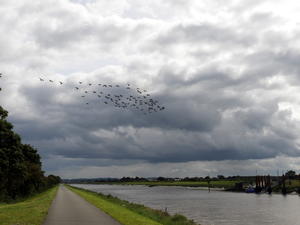
Chester Spoilt for choice! Chester has not one, but two wonderful traffic-free, tarmac cycleways heading to Wales. The original is the Millennium Greenway (NCN 5), built on the line of a former railway. Pick it up at Northgate, north of the city centre. But we think the newer route along the River Dee (NCN 568) has the edge for scenery.
Start at the Old Dee Bridge, within sight of Chester Weir, and head west past the racecourse. After its initial loops, the route settles down to follow the improved channel of the tidal Dee, a major commercial waterway for just one customer – Airbus. Their enormous complex, south of the Dee, uses river transport to ship wings out. The Dee is also a haven for birdlife; the sandbanks further out to sea are where the best sightings are, but you’ll see birds venturing upriver towards Chester too.
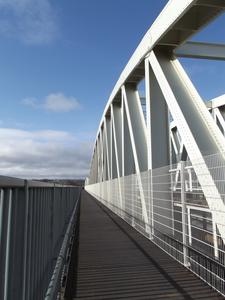
Hawarden Bridge (7mi) The cycleway crosses to the south bank on a deck beside Hawarden’s railway bridge. The next section is actually along the course of an old freight railway, which once linked the busy port of Connah’s Quay to the mines of Wrexham. Connah’s Quay is no longer a working port: the only boats moored up here are small pleasure craft. Still, the cycleway gets the best view, hugging the quayside before diving underneath the main road on the old railway trackbed.
The route through the town is circuitous but eventually returns to the main road. A shared-use roadside path, crossing from side to side, brings you into Flint. The tour of Flint on back streets might seem a gratuitous diversion, but it’s worth it to see the ruins of Flint Castle. Keep your eyes on the signs (or GPS) as navigation can be difficult. Flint has cafés and shops if you need supplies.
The roadside path continues towards Bagillt, eventually launching you onto the old High Street while traffic thunders along the main dual carriageway.
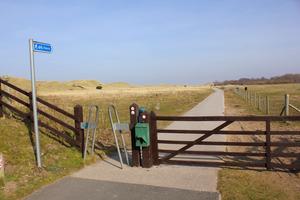
Bagillt (16mi) Decision time. You can follow the official NCN 5 route inland. It’s all on quiet roads, but it’s steep – with gradients of 12% soon after you leave the coast. Once you’re up there, it’s a lovely route, but don’t underestimate the initial climb.
Or you can do what we suggest, which is follow the coast road. Yes, there’s more traffic for a few miles, but this is a popular road for cyclists, so drivers shouldn’t be surprised to see you.
There’s not much to Bagillt bar the odd pub and corner shop. You can ride along the High Street, or follow the brand new (2021) cycleway along the north side of the main road. (The inland route branches off the High Street.) When the High Street and dual carriageway meet, at the western end of the village, duck along the pavement (technically a footway not a cycleway, but everyone rides it) for a few hundred yards until the next junction. Ride through Whelston on the wide old road until you meet the main A548 again.
From here you’re riding along the main road for 4.5 miles. There is a narrow pavement; we’d suggest sticking to the road through Walwen and Greenfield, but if you’re nervous, take the pavement on the north side when the 30mph limit ends. Return to the road at the traffic lights in Mostyn, and continue through the straggling village past the signalbox. Look out for a set of barriers into woodland on the right, and turn here. The cycleway has resumed!
This path eventually returns to the roadside, providing enjoyable, easy riding. Use the crossing by the railway footbridge to ride through Ffynnongroyw on the old road. When you meet the dual carriageway, head across the signal crossing, turn right (east) along the path for a few yards, and follow the cycleway through the barrier across the fields. This lovely new path past the dunes and caravan parks of Talacre is one of the most memorable parts of the route.

Prestatyn (29mi) We rejoin the official NCN 5 route just before Prestatyn, cycling serenely through the golf course before heading to the seafront. This is the very definition of coastal cycling, a wide, sand-swept promenade with waves lapping on the beach just a few yards away.
And it continues like this, more or less, for 17 blissful miles. Sometimes there’s a sandy beach, sometimes expanses of gravel, sometimes rocky sea defences. With the railway as your constant companion, you’ll coast gently past Rhyl, Kinmel Bay and Pensarn. It’s all smooth tarmac, with the occasional wiggle to keep things interesting. A new bridge takes you across the mouth of the River Clwyd at Rhyl; opened in 2013, it lifts to allow boat traffic to pass.
Colwyn Bay has a classic promenade lined with lofty apartments, but Rhos-on-Sea is your best bet for a bite to eat, with cafés, pubs and ice-cream parlours all directly beside the bike route.
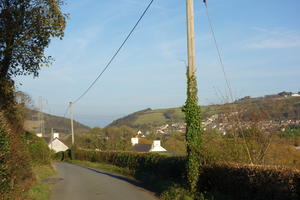
Llandudno (46mi) At Llandudno, you have a choice. You can take a shortcut across to Llandudno Junction and Conwy, missing the town of Llandudno entirely. Or you can loop through what is without question North Wales’s premier resort town.
The shortcut is a lovely ride along a quiet, shady lane with very little traffic. If you’ve already visited Llandudno, then we’d recommend this as an enjoyable option.
But if you have an afternoon to spare, Llandudno is a great place, full of character and history. The official route actually misses out the town centre for some reason. Ignore it, and ride along the promenade instead (opened to cyclists after a long campaign). Lock your bike up and explore the arcades and tourist shops of the town. Then stretch your climbing legs with a ride around the rocky Great Orme headland along Marine Drive, a single-track, one-way road with outstanding views – and gradients of up to 8%. There’s a café halfway round, aptly named Rest and Be Thankful. Enjoy the fast descent back to the beach, then rejoin the NCN 5 coastal cycleway (a little bumpy) back to Deganwy and Llandudno Junction.
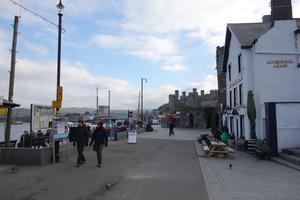
Conwy (52mi) Few towns have such a dramatic approach as Conwy. As you ride over the estuary bridge, every angle is a photographer’s delight. Telford’s fine suspension bridge to your left; colourful sailing boats at anchor to your right; and ahead, the magnificent Conwy Castle. Wooded hills in the distance and Conwy’s waterfront inns complete the scene.
Conwy is a near-compulsory stop, particularly on a sunny day when the waterfront is so thronged that you’ll probably need to get off and push. That’s no great hardship: all the better to appreciate this rich vista. The route niftily threads along the side of the estuary, skirting the steep cliffs before crossing the A55 expressway on a minor road bridge.
This is a startling section of the route. As the A55 tunnels under the Penmaenbach headland, the cycleway follows the old, steeper road alignment hewn out of the rock. It then nestles into a narrow space between the road and the railway, perhaps less scenic than the beachside path before Llandudno, but still enjoyable and with plenty of sea views. The bridges at Pen-y-Clip, after Penmaenmawr, were installed in 2009 and made a previously precarious length much more enjoyable.
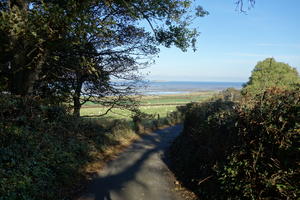
Llanfairfechan (60mi) The route formerly followed country lanes from Llanfairfechan to Bangor. Now, with the upgrading of the A55 main road, a high-quality cycleway has been built alongside. It’s smooth, easy, flat cycling – albeit not quiet given the proximity of the road.
(You can still follow the old road if you want to stretch your legs a bit. Narrow country roads with high hedges and little traffic follow the northern edge of the Carneddau mountains, peering down at the A55 below and the sea beyond. It’s hillier than before – you’ll hit the heady heights of 75m at one point. But it’s never strenuous, and the rural lanes feel like a breath of fresh inland air after so long beside the coast. Just follow the minor road out of Abergwyngresyn, rejoining the main route at the A55 junction at Ty’n yr hendre.)
On the run in to Bangor, the route joins NCN 82 (Lon Las Ogwen, a cul-de-sac route into Snowdonia) along a winding woodland cycleway. This follows the course of the old mineral railway along the Cegin valley. Where the river flows into the Menai Straits, the cycleway runs alongside the waterfront, heading for Bangor’s long but understated pier – bereft of the amusement arcades and gift shops that characterise many piers, but a lovely spot for a coffee and a cake while you watch seabirds wheeling by.
Bangor (69mi) Bangor Pier is the best place to end your ride. If you’re carrying on – to Anglesey, perhaps, or Caernarfon – then continue to follow the blue NCN 5 signs through the town. These will take you to the Menai Bridge, or to the rail-trail cycleway towards Caernarfon and, ultimately, South Wales via Lon Las Cymru. But you could do worse than turn back and retrace your steps…
Log in with your cycle.travel account:
| Password |
Or simply use your account on: